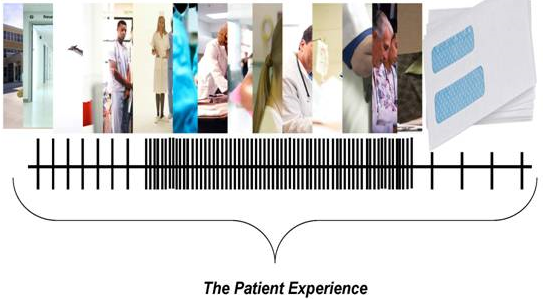The Patient Experience
The patient experience is comprised of a number of patient encounters and that number is growing every day as technological advancements drive greater fragmentation and specialization. Those encounters are both clinical and non-clinical but they all come together to create the patient experience.

The average hospital patient has six to eight encounters with a hospital before ever having his or her first clinical encounter. Those initial encounters such as the patient's ability to find the hospital, parking, the building's appearance, the registration process and ease of finding the right clinical area all work to set the stage for their initial reaction to their first clinical encounter. Building a healthy patient/provider relationship can start out challenged if the staging isn't set properly.
Once the patient enters the clinical piece of the experience, the encounters escalate sharply in number in many healthcare settings. This is a particular challenge for hospitals where a patient can have multiple encounters with different nurses, doctors, lab technicians, radiology technicians and therapists. This rapid fire sequencing of encounters inside the clinical experience is what is making consistency a new top contender as a pseudomeasure of quality.
The handling of patient complaints and systems that measure satisfaction also result in encounters that create perceptions. Critical questions in determining their impact inside that patient experience are how customer friendly and value-adding the patient perceives them to be. Superficial and soft activities in these areas can actually be more damaging than having no activity at all as they add insult to injury.
The final and perhaps most risky encounter in today's environment may be the patient bill. Inaccuracy, lack of timeliness, and complexity make the bill one of healthcare's greatest internal nemesis. While the bill may seem like a minor issue in the big picture for most providers, it is a very big deal for patients struggling to make ends meat in an environment where there seems to be no end in sight for the escalation of healthcare costs.
As the final encounter in many experiences, the bill is the most risky because it has the potential to undo all the good that came before it if it makes the patient angry enough. As the last encounter it is the most memorable. As the cost of health care has the potential to influence almost all other areas of a patient's life, because it impacts the availability of discretionary funds, patients don't take kindly to the idea of being ripped of, even when it is an honest mistake.
Consider a trip to WalMart. It is easy to find a parking place convenient to the Food Center Door. The parking lot is well lit and free of dangerous potholes and obstacles. Accessing the entrance is easy where you are greeted by a very friendly man who offers you a cart, thanks you for choosing WalMart and wishes you a great day. The store is well lit and clean. The shelves are well stocked and different areas of the store are well marked to facilitate finding things. You can find everything you want except three things. You ask three different clerks for help and each one walks you to what you are looking for and thank you for shopping at WalMart. Because one of the items is heavy and large, the sales associate offers to get a separate cart and take it to the front of the store for you. Once you get to the check out, the line is about eight people deep. Once you get to the clerk, she is obviously not having a great day. She tells you how she only has 40 minutes left on her shift, she counts your change wrong and when you get to your car (in the rain) you realize that two of your bags must still be on the turntable.
When you get home, what part of your WalMart experience will you share and potentially share over and over - the checkout. In addition to discussing it at the dinner table, you may twitter about it, share it on your Facebook and share it on a blog. That one encounter undid everything good that came before it because those encounters are not the ones you remember most vividly and talk about. If similar stories circulate too frequently in the community, it becomes a negative value proposition held by the community to be true.
An effective patient satisfaction system monitors the patient experience, identifying the positive encounters so they can be protected and rewarded while also identifying the negative encounters in order to provide for timely intervention and rescue of the patient/provider relationship.
Back to Satisfaction Basics
Back to The Business of Satisfaction

